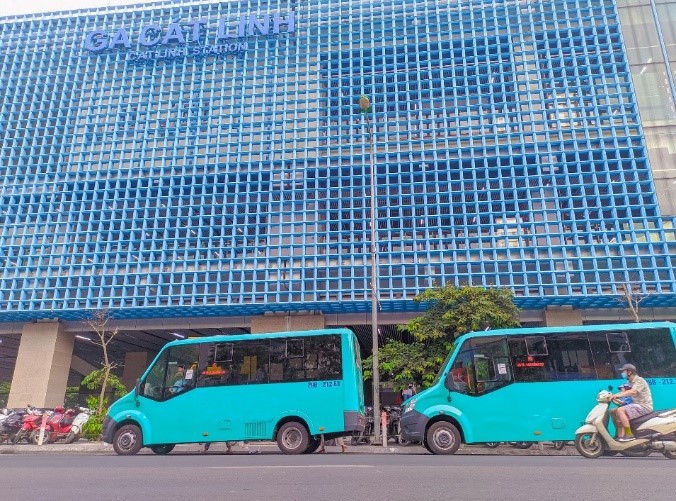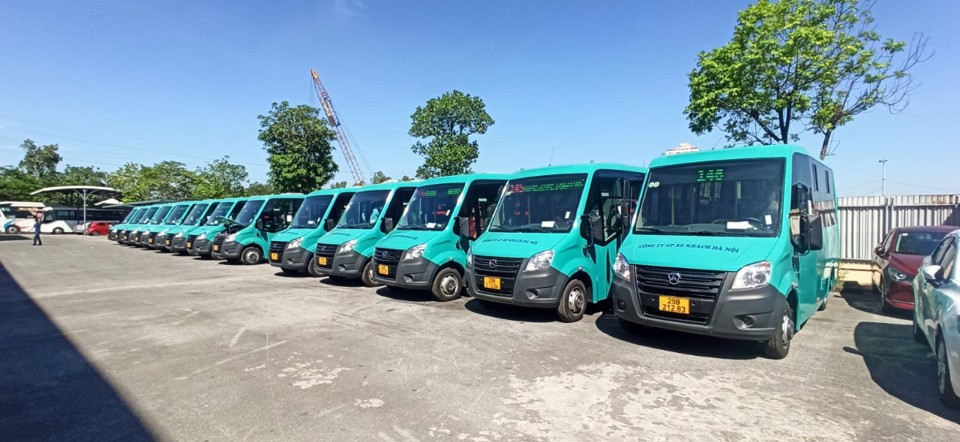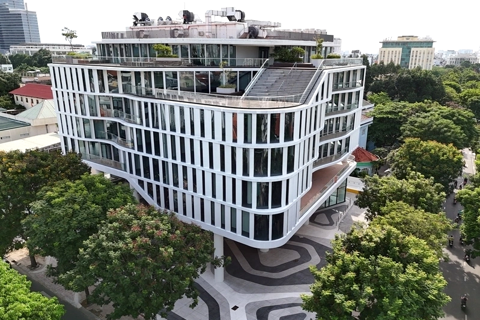Hanoi improves public transportation with more minibuses
Given their high maneuverability, mini-buses would be ideal for complementing the bus systems and urban railway networks.
In response to Hanoi's unique urban traffic landscape, characterized by numerous narrow streets and alleys, the city has introduced a variety of mini-bus routes operated by vehicles with a capacity of 20 to 30 passengers in recent years to improve transportation connectivity.
| Minibus route 146 connects with the Cat Linh - Ha Dong urban railway. Photo: Vu Khoa/The Hanoi Times |
As a thousand-year-old city with a network of narrow alleys intertwined with long-established residential areas, Hanoi faces the challenge of accommodating large buses in its urban traffic infrastructure.
In response to this unique urban landscape, the city has introduced a large number of mini-bus routes with smaller capacities (approximately 20-30 passengers). These mini-buses are designed to navigate the city's smaller neighborhoods without causing traffic congestion and ensure punctuality.
Of particular note, the Cat Linh - Ha Dong urban railway has recently commenced operations, and future plans include the rollout of several elevated railway lines. This underscores the growing importance of mini-buses in facilitating connectivity.
Given their high degree of maneuverability, mini-buses are ideal for complementing the bus systems and urban railway networks.
Furthermore, the use of minibusses helps to conserve resources. Since mini-bus routes typically cater to a moderate number of passengers, they are a cost-effective choice, contributing to savings in vehicle and fuel investment costs.
These mini-buses are not confined solely to the city center but are also deployed in suburban areas, linking tourist attractions and district centers on routes like 123 Yen Nghia - Hong Duong bus terminals (Thanh Oai District), bus route 124 Yen Nghia bus station - Chuc Son - Kim Bai Town, and bus route 125 Thuong Tin - Te Tieu bus station.
These suburban mini-bus routes, which serve inter-district lines and run on communal and dyke roads, have great potential for efficiently connecting the metropolitan area with the city's suburbs.
Mini-bus systems have long been in use around the world. Singapore has established a comprehensive network of 28 mini-bus stations with over 4,500 stops, making minibusses the backbone of the country's transportation system.
Thailand, with a transportation infrastructure similar to Vietnam, has also implemented a mini-bus transit system. Designed like pickup trucks, Thai mini-buses carry 10 to 15 passengers and can navigate narrow streets while maintaining punctuality.
Traffic expert Bui Danh Lien has noted that urban roads are often narrow, and the number of private vehicles continues to rise, making it challenging for large buses to maneuver.
“The expansion of small bus routes can alleviate traffic congestion and enhance connectivity with urban rail transit,” said Lien.
| These mini-buses are designed to navigate through the city's smaller neighborhoods without causing traffic congestion and ensure timeliness. |
A key part of the public transport network
It's worth mentioning that with the launch of the Cat Linh - Ha Dong urban railway, some businesses have taken the bold step of investing in mini-bus routes to enhance integration with the metro line, even though the revenue potential may not be as attractive as routes operated by larger buses (with a capacity of 40 to 80 passengers) on busy roads.
For instance, on July 1, 2022, the Hanoi Passenger Bus Joint Stock Company launched bus route 146 (Hao Nam - Administrative Center in Vo Chi Cong - Hao Nam) using small buses with just 22 seats.
The primary objective of mini-bus route 146 is to facilitate passenger connections with the Cat Linh - Ha Dong urban railway as well as their access to prominent tourist attractions and entertainment areas in the capital. Consequently, in a short span, bus route 146 has garnered considerable passenger interest, underscoring the effectiveness of mini-buses.
Nguyen Hoang Hai, Vice President of the Hanoi Public Transport Association, said that despite the city's ongoing development, large buses play a crucial role in the public transport system.
“This significance becomes even more pronounced when metro lines are integrated into a network, wherein mini-buses assume an increasingly vital role by providing people with optimal access to bus services,” said Hai.
“Given the traffic dynamics in the capital, characterized by numerous small roads, narrow streets, and a dispersed population, mini-buses hold particular importance. They bridge the gap in bus accessibility for residents and serve as an effective solution to enhance transportation connectivity in Hanoi,” he added.
The city's bus network covers all 30 districts and towns, with most communes accessible by bus. The public bus transport system also facilitates connections with neighboring provinces such as Hung Yen, Bac Giang, Ha Nam, and Bac Ninh. Looking ahead, buses will continue to play a pivotal role in the capital's mass transit network.













